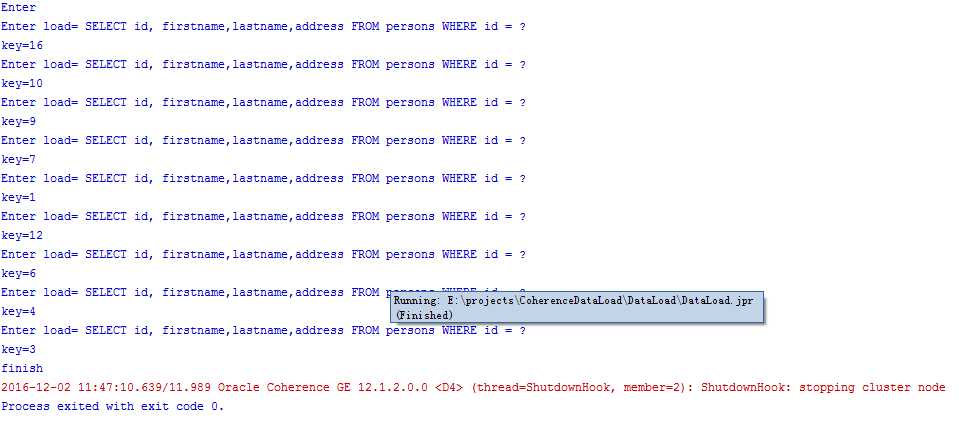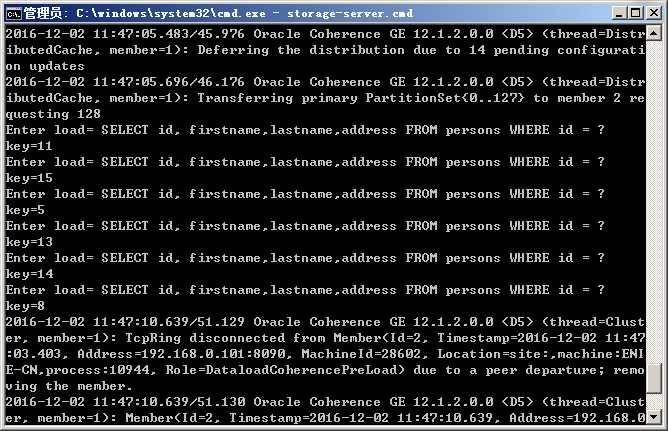|
package dataload;
import com.tangosol.net.CacheFactory;
import com.tangosol.net.NamedCache;
import com.tangosol.net.cache.CacheStore;
import com.tangosol.util.Base;
import com.tangosol.util.InvocableMap;
import java.sql.DriverManager;
import java.sql.Connection;
import java.sql.PreparedStatement;
import java.sql.ResultSet;
import java.sql.SQLException;
import java.util.Collection;
import java.util.Hashtable;
import java.util.Iterator;
import java.util.LinkedList;
import java.util.List;
import java.util.Map;
import javax.naming.Context;
import javax.naming.InitialContext;
import java.sql.ResultSet;
import java.sql.Statement;
import java.util.Collections;
import java.util.HashMap;
import java.util.Set;
import javax.naming.NamingException;
/**
* An example implementation of CacheStore
* interface.
*
* @author erm 2003.05.01
*/
public class DBCacheStore
extends Base
implements CacheStore
{
// ----- constructors ---------------------------------------------------
/**
* Constructs DBCacheStore for a given database table.
*
* @param sTableName the db table name
*/
public DBCacheStore(String sTableName)
{
m_sTableName = sTableName;
cache = CacheFactory.getCache("SampleCache");
}
// ---- accessors -------------------------------------------------------
/**
* Obtain the name of the table this CacheStore is persisting to.
*
* @return the name of the table this CacheStore is persisting to
*/
public String getTableName()
{
return m_sTableName;
}
/**
* Obtain the connection being used to connect to the database.
*
* @return the connection used to connect to the database
*/
public Connection getConnection() {
try {
Context ctx = null;
Hashtable<String,String> ht = new Hashtable<String,String>();
ht.put(Context.INITIAL_CONTEXT_FACTORY,"weblogic.jndi.WLInitialContextFactory");
ht.put(Context.PROVIDER_URL,"t3://localhost:7001");
ctx = new InitialContext(ht);
javax.sql.DataSource ds= (javax.sql.DataSource) ctx.lookup("ds");
m_con = ds.getConnection();
} catch (Exception e) {
System.out.println(e.getMessage());
}
return m_con;
}
// ----- CacheStore Interface --------------------------------------------
/**
* Return the value associated with the specified key, or null if the
* key does not have an associated value in the underlying store.
*
* @param oKey key whose associated value is to be returned
*
* @return the value associated with the specified key, or
* <tt>null</tt> if no value is available for that key
*/
public Object load(Object oKey)
{
Object oValue = null;
Person person = null;
Connection con = getConnection();
String sSQL = "SELECT id, firstname,lastname,address FROM " + getTableName()
+ " WHERE id = ?";
System.out.println("Enter load= "+sSQL);
try
{
PreparedStatement stmt = con.prepareStatement(sSQL);
stmt.setString(1, String.valueOf(oKey));
System.out.println("key="+String.valueOf(oKey));
ResultSet rslt = stmt.executeQuery();
if (rslt.next())
{
person = new Person(rslt.getString("id"),rslt.getString("firstname"),rslt.getString("lastname"),rslt.getString("address"));
oValue = person;
if (rslt.next())
{
throw new SQLException("Not a unique key: " + oKey);
}
}
stmt.close();
}
catch (SQLException e)
{
System.out.println("=============="+e.getMessage());
//throw ensureRuntimeException(e, "Load failed: key=" + oKey);
}
return oValue;
}
/**
* Store the specified value under the specific key in the underlying
* store. This method is intended to support both key/value creation
* and value update for a specific key.
*
* @param oKey key to store the value under
* @param oValue value to be stored
*
* @throws UnsupportedOperationException if this implementation or the
* underlying store is read-only
*/
public void store(Object oKey, Object oValue)
{
/*
Connection con = getConnection();
String sTable = getTableName();
String sSQL;
if (load(oKey) != null)
{
sSQL = "UPDATE " + sTable + " SET value = ? where id = ?";
}
else
{
sSQL = "INSERT INTO " + sTable + " (value, id) VALUES (?,?)";
}
try
{
PreparedStatement stmt = con.prepareStatement(sSQL);
int i = 0;
stmt.setString(++i, String.valueOf(oValue));
stmt.setString(++i, String.valueOf(oKey));
stmt.executeUpdate();
stmt.close();
}
catch (SQLException e)
{
throw ensureRuntimeException(e, "Store failed: key=" + oKey);
}
*/
}
/**
* Remove the specified key from the underlying store if present.
*
* @param oKey key whose mapping is to be removed from the map
*
* @throws UnsupportedOperationException if this implementation or the
* underlying store is read-only
*/
public void erase(Object oKey)
{
/*
Connection con = getConnection();
String sSQL = "DELETE FROM " + getTableName() + " WHERE id=?";
try
{
PreparedStatement stmt = con.prepareStatement(sSQL);
stmt.setString(1, String.valueOf(oKey));
stmt.executeUpdate();
stmt.close();
}
catch (SQLException e)
{
throw ensureRuntimeException(e, "Erase failed: key=" + oKey);
}
*/
}
/**
* Remove the specified keys from the underlying store if present.
*
* @param colKeys keys whose mappings are being removed from the cache
*
* @throws UnsupportedOperationException if this implementation or the
* underlying store is read-only
*/
public void eraseAll(Collection colKeys)
{
throw new UnsupportedOperationException();
}
/**
* Return the values associated with each the specified keys in the
* passed collection. If a key does not have an associated value in
* the underlying store, then the return map will not have an entry
* for that key.
*
* @param colKeys a collection of keys to load
*
* @return a Map of keys to associated values for the specified keys
*/
public Map loadAll(Collection colKeys)
{
/* System.out.println("Enter LoadAll Map");
Map mapResults = new HashMap();
for (Object entry : (Set<Object>) colKeys) {
System.out.println(entry);
mapResults.put(entry, load(entry));
}
return mapResults;
*/
return Collections.emptyMap();
//throw new UnsupportedOperationException();
}
/**
* Store the specified values under the specified keys in the underlying
* store. This method is intended to support both key/value creation
* and value update for the specified keys.
*
* @param mapEntries a Map of any number of keys and values to store
*
* @throws UnsupportedOperationException if this implementation or the
* underlying store is read-only
*/
public void storeAll(Map mapEntries)
{
throw new UnsupportedOperationException();
}
/**
* Iterate all keys in the underlying store.
*
* @return a read-only iterator of the keys in the underlying store
*/
public Iterator keys()
{
Connection con = getConnection();
String sSQL = "SELECT id FROM " + getTableName();
List list = new LinkedList();
try
{
PreparedStatement stmt = con.prepareStatement(sSQL);
ResultSet rslt = stmt.executeQuery();
while (rslt.next())
{
Object oKey = rslt.getString(1);
list.add(oKey);
}
stmt.close();
}
catch (SQLException e)
{
throw ensureRuntimeException(e, "Iterator failed");
}
return list.iterator();
}
// ----- data members ---------------------------------------------------
/**
* The connection.
*/
protected Connection m_con;
/**
* The db table name.
*/
protected String m_sTableName;
protected NamedCache cache;
}
|



